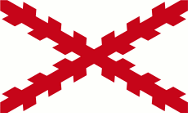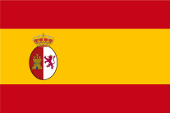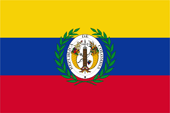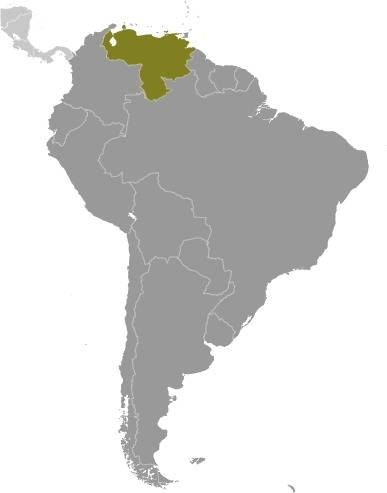zur deutschen Version, Flagge klicken oder tippen

- Bolivarian Republic of Venezuela
- presidial republic
- own name: República Bolivariana de Venezuela
• Flags
• Historical Flags
• Meaning/Origin of the Flag
• Coat of Arms
• Historical Coats of Arms
• Meaning/Origin of the Coat of Arms
• Aircraft Roundel
• Map
• Numbers and Facts
• History
• Origin of the Country's Name

since 2006,
National, state and naval flag,
ratio = 2:3,
Source, by: Flags of the World






since 2006,
Merchant flag,
ratio = 2:3,
Source, by: Flags of the World




since 2006,
Naval jack,
ratio = 2:3,
Source, by: Flags of the World




since 2006,
Standard of the President ashore,
ratio = 1:1,
Source, by: Flags of the World, Wikipedia (EN)




since 2006,
Standard of the President offshore,
ratio = 2:3,
Source, by: Flags of the World, Wikipedia (EN)





1535–1717,
Flag of the Viceroyalty of New Spain
Source, by:
Wikipedia (ES)




1717–1785,
Flag of the Viceroyalty of New Granada
Source, by:
Wikipedia (ES)




1785–1819,
Flag of the Viceroyalty of New Granada
Source, by:
Wikipedia (ES)




1777–1824,
Flag of the General-Captaincy of Venezuela,
Source, by: Flags of the World




1806, Coro,
Flag of Francisco de Miranda in Coro,
Source, by: Wikipedia (ES)




1810–1811,
Flag of the loyal Junta,
Source, by: Flags of the World, Wikipedia (ES)




1811,
Flag of the United Provinces,
Source, by: Wikipedia (ES)




1811,
Flag of Venezuela,
Source, by: Wikipedia (ES)




1812,
Flag of Venezuela,
Source, by: Wikipedia (ES), using Salvadoroff,
CC BY-SA 4.0, via Wikimedia Commons




1813–1816,
Flag of Spain,
Source, by: Flags of the World




1817,
Flag of Venezuela,
Source, by: Wikipedia (ES)




Mai/May–November 1817,
National and naval flag,
Source, by: Flags of the World, Wikipedia (ES)




1817–1819,
National and naval flag,
Source, by: Flags of the World, Wikipedia (ES)




1819–1820,
Flag of Greater Colombia,
Source, by: HansenBCN [CC BY-SA 4.0],
via Wikimedia Commons




1820–1821,
Flag of Greater Colombia,
Source, by: Milenioscuro [CC BY-SA 3.0],
via Wikimedia Commons




1821–1830,
Flag of Greater Colombia,
Source, by: Milenioscuro [CC BY-SA 3.0],
via Wikimedia Commons




1822–1830,
common flag of Greater Colombia,
Source, by: Die Welt der Flaggen




1830–1836,
National flag of Venezuela,
Source, by: Flags of the World, Wikipedia (ES)




1836–1863,
National flag of Venezuela,
Source, by: Flags of the World, Wikipedia (ES)




1859–1863,
Flag of the Junta of Coro,
Source, by: Flags of the World, Wikipedia (ES)




1863–1905,
National, state and naval flag,
ratio = 2:3,
Source, by: Flags of the World, Wikipedia (ES)




1863–1905,
Merchant flag,
ratio = 2:3,
Source, by: Flags of the World, Wikipedia (ES)




1905–1930,
National, state and naval flag,
ratio = 2:3,
Source, by: Flags of the World, Wikipedia (ES)




1905–1930,
Merchant flag,
ratio = 2:3,
Source, by: Flags of the World, Wikipedia (ES)




1930–2006,
National, state and naval flag,
ratio = 2:3,
Source, by: Flags of the World, Wikipedia (ES)






1930–2006,
Merchant flag,
ratio = 2:3,
Source, by: Flags of the World, Wikipedia (ES)






1970s,
Standard of the President,
ratio = 1:1,
Source, by: Flags of the World




The flag of Venezuela was introduced in its current form in 1930 and officially confirmed in 1954 and again in 2006. It was adopted in its basic form in 1811 and has been slightly modified ever since, most recently on 12th of March in 2006 with a change in the coat of arms and the number of white stars. The flag shows three horizontal stripes in yellow, blue and red. In the centre of the blue stripe are eight white stars arranged in an arc. Before 2006 there were seven stars. They stood for the seven former provinces that signed the Declaration of Independence. The eighth star represents the historical province of Guyana and commemorates Simón Bolívar's decree of 20th of November in 1817, in which he ordered the inclusion of an eighth star for Guyana. The national, state and naval flags also show the coat of arms of the state in the upper corner in the yellow stripe on the mast. The colours yellow, blue and red are intended to symbolise the separation of the country (national colour: yellow) from the colonial power Spain (national colour: red) by the sea (blue). Yellow also symbolises the country's wealth, the sunshine and the cornfields. Blue symbolises the sky, the ocean and the rivers, and red stands for the blood shed for independence. The colour combination goes back to the Venezuelan freedom fighter Francicso de Miranda (1750–1816). He used a flag with these colours for the first time in 1801 in London, in the arrangement red-yellow-blue. The colours of the flag can be traced back to Johann Wolfgang von Goethe, who had developed his own colour theory and drew Miranda's attention to his ideas about colours and their psychological principles of action in Weimar in 1785, describing yellow, blue and red as the colours mainly perceived by humans. Miranda adopted these colours. It is often assumed that Miranda chose "light blue", which can also be found on some depictions of flags from this region and time. This is problematic. Flags as historical artefacts are often viewed with a modern eye and a specific colour designation is quickly applied. This completely ignores the fact that the light blue is due to washing out and fading, a property of indigo (there was no other dye at the time) that is still known and exploited today. Ecuador and Venezuela use similar flags, a reference to the former historical union of the countries of Ecuador, Venezuela and Colombia within Greater Colombia. The territory of present-day Venezuela was colonised by Spain from 1500, so that the red and yellow flags of Spain were used, officially from 1535, when the Viceroyalty of New Spain, to which present-day Venezuela belonged, was founded. After Charles the Bold, the last heir to the House of Burgundy, fell in the Battle of Nancy in 1477, the House of Habsburg claimed his inheritance. When the Habsburgs came to power with Charles I. in Spain in 1516, a new flag was introduced for use at sea and overseas. It was white and showed the red diagonal cross of the Burgundians. However, flags in red and yellow remained in use and had a very different appearance, often showing crosses but also several stripes. In 1777, the General Captaincy of Venezuela was formed, which was only formally subordinated to the Viceroyalty of New Granada, to which the territory of Venezuela had belonged since 1717. The Captaincy General of Venezuela is also said to have had its own flag, although this is not entirely certain. It is said to have shown a yellow diagonal cross on a green background. A new Spanish flag was introduced in 1785. Its main purpose was to better identify Spanish ships at sea, as there were many white flags at that time. The freedom fighter Francisco de Miranda began agitating for the fight against Spain in 1801 and endeavoured to recruit volunteers for his "Columbiano Army". He also presented a flag with three horizontal stripes in red, yellow and blue. Francisco de Miranda wanted to debark his military force in Ocumare de la Costa on 28th of April in 1806, but this failed after a sea battle. Two of his ships fell into the hands of the Spanish. The Spaniards also captured a flag in black, red and gold, which should have become the flag of the "Columbiano Army". Francisco de Miranda then landed in Coro on 3rd of August in 1806 with his small force and was able to occupy the town for a few days. Francisco Labastida, the servant of the parish church, described the flag carried by Francisco de Miranda as having three stripes, blue at the top, yellow in the centre and red at the bottom. The freedom movement spreading throughout the country almost led to a coup in Caracas in 1808. As Spain's power gradually began to falter, the "Supreme Conservative Junta of the Rights of Ferdinand VII" was formed in Caracas as a counter-movement. Its symbol, mainly used as an armband, was three stripes in red, yellow and black and the initials of King Ferdinand VII. of Spain were placed in the yellow stripe: "FVII". On 5th of July in 1811, the struggle for independence began and the provinces of Barcelona, Barinas, Caracas, Cumaná, Margarita, Mérida and Trujillo broke away from Spain to form the "United Provinces of Venezuela". Francisco de Miranda presented the Congress of Provinces with a flag in yellow, blue and red. On 9th of July in 1811, the Congress, now the Supreme Congress of Venezuela, adopted a design by Francisco de Miranda and Lino de Clemente as the national flag. This flag again showed three stripes in yellow, blue and red, but the yellow stripe was twice as wide as the others to make room for an allegory in the upper corner. This showed an Indian woman sitting on a rock with a rod in her hand with a Phrygian cap on top, a rising sun, an alligator and various fruits, the inscription "Venezuela" and a ribbon with the word "Colombia" at the bottom. On 15th of February in 1812, the flag was changed, the upper corner now showed a condor with a stylised sun on its chest, holding arrows and a caduceus in its claws, above a banner with the motto: "Concordia Res Parve Crescunt" → "Small states grow through concord". Between 1813 and 1816, Spain regained control of Venezuela, but was forced to grant independence to the country on 7th of May in 1816. On 12th of May in 1817, the flag of 1811 was reintroduced. However, as it was difficult to produce, a flag was initially used for the navy with an upper, large, yellow field with seven blue stars (representing the seven provinces), but was also used as the national flag. On 20th of November in 1817, after the successful military Guyana campaign, General Simón Bolívar ordered that an eighth star (for Guyana) be added. On 17th of December in 1819, the United Provinces of New Granada (later Colombia) merged with the provinces of Quito (Ecuador) and Venezuela under the leadership of Simón Bolívar to form the Republic of Greater Colombia. There was also to be a new flag for this country. The colours yellow, blue and red were adopted and used for the country's flag, again with the broad yellow stripe, which now showed an allegory with a seated Indian in the upper corner. After just one year, the coat of arms was changed, with the blue shield now showing a condor and several stars. However, the regulations were inconsistent and the coat of arms controversial, so that the flags of Colombia and Venezuela could officially continue to be used. On 4th of October in 1821, the General Congress of Greater Colombia passed the resolution on the coat of arms. It was now a kind of cartouche showing a bundle of lictors and two cornucopias and the name of the country around it. It was now placed in the centre of the flag, which now had three stripes of equal width. This flag was retained until the end of Greater Colombia in 1830. There were also variants of the flag that placed the coat of arms in the upper corner of the previous flag. In practice, however, the flag of Greater Colombia was often used without the coat of arms, with three blue stars added to the upper corner. These stood for the three parts of the country: New Granada, Venezuela and Quito. This flag was certainly easier to produce again. After the death of Simón Bolívar in 1830, Greater Colombia split into the states of New Granada, Venezuela and Ecuador. Venezuela initially and provisionally retained the colours of the flag of Greater Colombia and the coat of arms was also used in a slightly modified form. In 1836, a new coat of arms was adopted for the United States of Venezuela, largely similar to the current version, which was placed in the yellow stripe in the upper corner of the unchanged flag. In 1859, there was a coup in the city of Coro and a junta decreed that the flag of the Republic of Venezuela from May 1817 be reintroduced as the national flag. The ensuing disputes led to the Treaty of Coche, with which the junta prevailed in 1863 and it was decided to place the seven white stars of 1817 in middle of the blue field of the yellow-blue-red flag, six stars grouped around a central star. In 1905, by order of the President, the stars were arranged in a circle in the centre of the blue field. Another change was made in 1930, this time by the congress, when the circular arrangement of the seven stars was cancelled and they were instead placed in a semicircle in the centre of the blue field.
Source:
Die Welt der Flaggen,
Flaggen Wappen Hymnen,
Flaggen und Wappen der Welt,
Wikipedia (ES)


since 2006,
Coat of arms of Venezuela,
Source: Wikipedia (ES), Corel Draw 4


1830–1836,
Coat of arms of Venezuela,
Source: Wikipedia (ES), Corel Draw 4

1836–1863,
Coat of arms of Venezuela,
Source: Wikipedia (ES), Corel Draw 4

1863–1905,
Coat of arms of Venezuela,
Source: Wikipedia (ES), Corel Draw 4

1905–1930,
Coat of arms of Venezuela,
Source: Wikipedia (ES), Corel Draw 4

1930–1954,
Coat of arms of Venezuela,
Source: Wikipedia (ES), Corel Draw 4

1954–2006,
Coat of arms of Venezuela,
Source: Wikipedia (ES), Corel Draw 4

The coat of arms of Venezuela was adopted in 1836. Changes in details were made in 1863, 1905, 1930, 1954 and most recently in 2006. The shield is divided party per fess and in the upper part party per pale. The first field is red and shows a golden sheaf of grain, the second field is golden and shows an allegorical representation of sabres and flags, the lower half of the shield is blue and shows a white wild horse on a green ground. The sheaf of grain symbolises unity and fertility, the sabres and flags embody independence and military success, the wild horse stands for freedom. Above the shield are two cornucopias. They symbolise prosperity. Below the shield is a ribbon in the national colours. Since 1930, it has shown the name of the country, the words "INDEPENDENCIA" and "FEDERACION" and two dates, 19th of April in 1810 (independence from Spain) and 20th of February in 1859 (start of the federal war in Venezuela). The coat of arms was last changed on 12th of March 2006, together with the flag. The wild horse, which originally ran to the right and looked back to the left, was turned so that it runs and looks to the left. The colour of the inscription on the ribbon below the shield changed from silver to gold and the name of the state was changed from "Republic of Venezuela" to "Bolivarian Republic of Venezuela".
Source:
Die Welt der Flaggen,
Flaggen Wappen Hymnen,
Flaggen und Wappen der Welt,
Wikipedia (ES)


Aircraft Roundel,
Source, by: Wikipedia (EN)

Aircraft roundel for naval aviation,
Source, by: Wikipedia (EN)

Location:

Source: CIA World Factbook
Map of the country:

Source: CIA World Factbook

Area: 352.143 square miles
Inhabitants: 31.250.000 (2024), thereof 51,6 % Mestizo, 43,6 % Europeans, 3,6 % Blacks (Afro-Americans), 2,8 % native Indian
Religions: 96 % Roman Catholic, 2 % Protestant
Density of Population: 89 inh./sq.mi.
Capital: Caracas (Santiago de León de Caracas), 1.943.901 inh. (2013)
official Language: Spanish, locally also native Indian languages
Currency (official): 1 Bolívar (VED) = 100 Céntimos
Currency (unofficial): 1 US-Dollar (USD, US$, $) = 100 Cent
Time Zone: GMT – 4 h
Source: Wikipedia (DE), Wikipedia (EN)

early times/ancient times · settlement by Aruak, Carib and other indigenous peoples
1498 · discovery by the Spanish navigator Christopher Columbus
1499 · the Spaniards Alonso de Ojeda and Amerigo Vespucci explore the coast and the interior of the country
1500 · start of colonisation by Spain, formation of three colonies (Venezuela [Coro], Nueva Andalucia [Cumaná] and Trinidad-Orinoco, the country is subordinated under the administration of the Colony of Santo Domingo
1528–1556 · Emperor Charles V. gives the country to the German banking house Welser as a fief due to its high debts; the banking house endeavours to collect the debts from the country, with the special assistance of a troop of lansquenets under Ambrosius Alfinger; the oppression and exploitation gets so out of hand that the emperor confiscates the fief.
1535 · formation of the Viceroyalty of New Spain, to which today's Venezuela belongs
1717 · formation of the Viceroyalty of New Granada, which comprises the present-day states of Colombia, Venezuela, Ecuador and Panama
1724 · Venezuela is annexed to the Colony of Santo Domingo
1739 · Venezuela is annexed to the Viceroyalty of New Granada
1742 · foundation of the province of Venezuela
1777 · foundation of the General Captaincy of Venezuela (Venezuela-Coro, Nueva Andalucia, Trinidad-Orinoco, La Grita, Trinidad and Guyana)
1781 · major anti-Spanish uprising
1797 · United Kingdom occupies Trinidad
1802 · Spain officially cedes Trinidad to United Kingdom
1806 · uprising under Francisco de Miranda
1810 · uprising under Simón Bolívar, deposition of the viceroy, but local government loyal to Spain
14th of July 1811 · independence
1812 · Spain reconquers the country
7th of May 1816 · renewed independence
1819 · proclamation of the Republic of Greater Colombia (former Viceroyalty of New Granada)
1830 · Venezuela and Ecuador secede from Greater Colombia due to civil wars
1835–ca.1900 · phase of constant coups and civil wars
24th of October 1830 · proclamation of the Republic of Venezuela
3rd of May 1864 · New Constitution, United States of Venezuela
19th of April 1953 · New Constitution, Republic of Venezuela
1992 · Venezuela becomes the third richest country in the world
1998 · election of socialist President Hugo Chávez, who denounces inequalities in the population's income, among other things
30th of December 1999 · new constitution, Bolivarian Republic of Venezuela
2004 · the private healthcare system is nationalised
2007 · higher education becomes free
2009 · private ownership of weapons is banned
2011 · start of economic decline, increase in corruption and mismanagement
2013 · death of Hugo Chávez, Nicolás Maduro becomes his successor
2014 · opposition leaders are imprisoned
2016 · food and medicine shortages
2016/2017 · attempts at peace agreements between the government and FARC and ELN
2017 · the constitution is suspended, regular elections are not held, election of a Constituent Assembly (Asamblea Nacional Constituyente), parliament is ousted, inflation, national bankruptcy
2018 · presidential election, wave of refugees
2020 · presidential election, riots
Source:
Atlas zur Geschichte,
Wikipedia (D),
Discovery '97,
World Statesmen,
www.express.co.uk

The name "Venezuela" goes back to the Italian navigator Amerigo Vespucci, who remembers the city of Venice as he saw coast near the today's town of Coro and the construction of the Indian villages with their houses on stilts. He named the country "Veneciola", "Little Venice". However, it was also just called "Tierra Firma" (mainland) or even "Castilla del Oro" (Golden Castille).
Source:
Handbuch der geographischen Namen,
Wikipedia (EN)


![]()





































































































